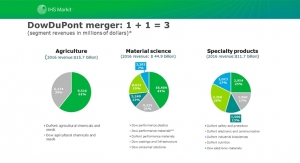Kerry Pianoforte, Editor10.02.17
Over the past few weeks the U.S. has been hit by two monster storms. Hurricane Harvey devastated parts of Texas and Hurricane Irma is currently battering the Caribbean and Florida. The human devastation is stunning and the extent of the damage is still being assessed. Recovery for these regions could take months if not years. Further complicating matters is the affect these storms will have on the supply of the chemicals industry.
Hurricane Harvey hit the U.S. Gulf Coast hard and is having a huge impact on the supply side of the U.S. chemicals industry. According to Kevin McCarthy, a chemical analyst at Vertical Research Partners, “the combination of Harvey’s path, duration and rainfall total is wreaking havoc with the supply side of the U.S. chemicals industry on an unprecedented scale.”
He cautions that price hikes are likely as the storm ends and visibility improves. “At least in the short term, we suspect that prices for most petrochemicals will move higher,” he predicted.
The latest report from IHS Markit estimated that eight of the 20 refineries affected by Harvey are now operating at “normal” rates. And all but one of the other 12 are beginning restart procedures or actively ramping up production.
Including the impact of refineries that are partially operational, IHS Markit estimated that approximately 2.9 million b/d of distillation capacity (16 percent of U.S. total) is offline as of September 6. This is down from 4.8 million b/d (27 percent of U.S. total) just one week ago. This total is expected to decline steadily over the next several days, falling to 1.6 million b/d (9 percent of U.S. total).
According to IHS analysts, the faster-than-expected recovery by the refining industry has calmed product markets. “Spot gasoline prices have declined for the past several days as fears of a broader supply crunch dissipate. However, the U.S. average retail gasoline price continues to trend upward as the impact of last week’s market upheaval works its way through the supply chain. Retail prices are also being pulled upward by Hurricane Irma, currently a Category 5 storm bearing down on Florida.”
While the extent of Irma’s damage to Florida and the Caribbean is still not fully known, it is clear that rebuilding houses and other infrastructure will be a massive undertaking. According to a New York Times article, AIR Worldwide, a catastrophe modeling firm in Boston, Irma’s insured damage in the U.S. is predicted to cost the insurance industry $20 billion to $40 billion. If insured property in the Caribbean is included, the total projected losses could range from $25 billion to $55 billion. All of this will result in a huge need for building and construction materials.
Hurricane Harvey hit the U.S. Gulf Coast hard and is having a huge impact on the supply side of the U.S. chemicals industry. According to Kevin McCarthy, a chemical analyst at Vertical Research Partners, “the combination of Harvey’s path, duration and rainfall total is wreaking havoc with the supply side of the U.S. chemicals industry on an unprecedented scale.”
He cautions that price hikes are likely as the storm ends and visibility improves. “At least in the short term, we suspect that prices for most petrochemicals will move higher,” he predicted.
The latest report from IHS Markit estimated that eight of the 20 refineries affected by Harvey are now operating at “normal” rates. And all but one of the other 12 are beginning restart procedures or actively ramping up production.
Including the impact of refineries that are partially operational, IHS Markit estimated that approximately 2.9 million b/d of distillation capacity (16 percent of U.S. total) is offline as of September 6. This is down from 4.8 million b/d (27 percent of U.S. total) just one week ago. This total is expected to decline steadily over the next several days, falling to 1.6 million b/d (9 percent of U.S. total).
According to IHS analysts, the faster-than-expected recovery by the refining industry has calmed product markets. “Spot gasoline prices have declined for the past several days as fears of a broader supply crunch dissipate. However, the U.S. average retail gasoline price continues to trend upward as the impact of last week’s market upheaval works its way through the supply chain. Retail prices are also being pulled upward by Hurricane Irma, currently a Category 5 storm bearing down on Florida.”
While the extent of Irma’s damage to Florida and the Caribbean is still not fully known, it is clear that rebuilding houses and other infrastructure will be a massive undertaking. According to a New York Times article, AIR Worldwide, a catastrophe modeling firm in Boston, Irma’s insured damage in the U.S. is predicted to cost the insurance industry $20 billion to $40 billion. If insured property in the Caribbean is included, the total projected losses could range from $25 billion to $55 billion. All of this will result in a huge need for building and construction materials.












